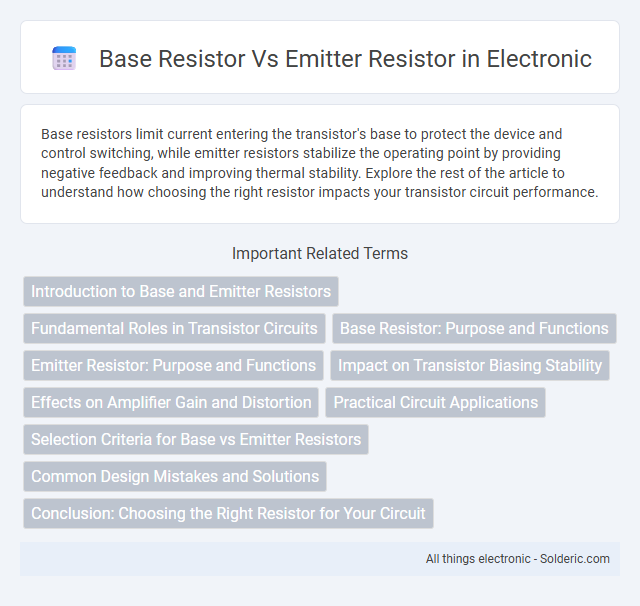Base resistors limit current entering the transistor's base to protect the device and control switching, while emitter resistors stabilize the operating point by providing negative feedback and improving thermal stability. Explore the rest of the article to understand how choosing the right resistor impacts your transistor circuit performance.
Comparison Table
| Feature | Base Resistor | Emitter Resistor |
|---|---|---|
| Purpose | Limits base current to protect transistor | Stabilizes emitter current and improves bias stability |
| Location | Connected to transistor base | Connected to transistor emitter |
| Effect on Gain | Minimal direct effect | Reduces voltage gain (degeneration) |
| Thermal Stability | Low improvement | Significant improvement in thermal stability |
| Signal Linearization | Not typically used for linearization | Reduces distortion, improves linearity |
| Complexity | Simple addition, low cost | Requires careful value selection |
| Common Applications | Basic current limiting in switching circuits | Analog amplifiers, bias stabilization |
Introduction to Base and Emitter Resistors
Base resistors control the input current to the transistor, protecting it from excessive base current and stabilizing signal input. Emitter resistors provide negative feedback, enhancing thermal stability and preventing thermal runaway by minimizing variations in emitter current. Understanding these resistor functions is essential for designing reliable amplifier circuits and optimizing transistor performance.
Fundamental Roles in Transistor Circuits
Base resistors control the input current to a transistor, protecting the base-emitter junction from excessive current and ensuring proper biasing. Emitter resistors stabilize the transistor's operating point by providing negative feedback, improving thermal stability and linearity in amplification. Together, these resistors enhance circuit reliability and performance by managing current flow and maintaining consistent transistor operation.
Base Resistor: Purpose and Functions
The base resistor controls the base current to protect the transistor from excessive current, ensuring stable operation within its safe limits. It also helps in biasing the transistor by setting the appropriate input impedance and preventing loading of the preceding stage. By properly selecting the base resistor value, you can optimize switching speed and improve circuit reliability.
Emitter Resistor: Purpose and Functions
The emitter resistor in a transistor circuit stabilizes the operating point by providing negative feedback that reduces variations in emitter current due to temperature changes or transistor parameter shifts. It improves linearity in amplification by controlling gain and minimizing distortion, ensuring consistent performance. Additionally, the emitter resistor enhances thermal stability and protects the transistor from excessive current by dropping voltage proportional to the emitter current.
Impact on Transistor Biasing Stability
Base resistors and emitter resistors significantly influence transistor biasing stability by controlling current flow and voltage levels in different ways. Base resistors limit base current, reducing noise and protecting against excessive input signals but offer less stabilization against temperature variations. Emitter resistors provide negative feedback by increasing voltage drop with rising emitter current, enhancing bias stability and minimizing thermal runaway, making them crucial for maintaining reliable transistor operation in your circuits.
Effects on Amplifier Gain and Distortion
Base resistors affect amplifier gain by limiting base current, which can reduce gain and increase input impedance, while emitter resistors provide negative feedback that stabilizes and linearizes gain, significantly reducing distortion. Using an emitter resistor improves amplifier linearity by counteracting transistor parameter variations, resulting in lower harmonic distortion compared to relying solely on a base resistor. To optimize your amplifier's performance, incorporate emitter resistors for consistent gain and minimal distortion, reserving base resistors primarily for input current control.
Practical Circuit Applications
Base resistors control the base current of a transistor, preventing excessive current that could damage the device in switching circuits and amplifiers. Emitter resistors provide negative feedback by stabilizing the emitter current, enhancing thermal stability and linearity in analog amplifier designs. In practical applications, combining both resistors ensures reliable transistor operation, reducing distortion and improving overall circuit performance.
Selection Criteria for Base vs Emitter Resistors
When selecting between a base resistor and an emitter resistor, consider their impact on transistor stability and gain control. A base resistor primarily limits the base current and protects the transistor from excessive input current, while an emitter resistor provides negative feedback that stabilizes operating point and reduces distortion by controlling emitter current. Your choice depends on the desired balance between thermal stability, signal linearity, and overall circuit biasing needs.
Common Design Mistakes and Solutions
Using an incorrect value for the base resistor can lead to excessive base current, causing thermal runaway or inefficient transistor switching. Neglecting the emitter resistor often results in poor stability and increased distortion due to lack of negative feedback. To ensure reliable operation, use a base resistor to limit current and incorporate an emitter resistor to stabilize the transistor's operating point and improve linearity in your amplifier design.
Conclusion: Choosing the Right Resistor for Your Circuit
Base resistors control the base current to ensure proper transistor switching, while emitter resistors provide stability by reducing gain variations and thermal runaway in amplifiers. Selecting the right resistor depends on circuit goals: use base resistors for precise current limiting and emitter resistors for improved bias stability and linearity. Optimizing these resistors enhances overall transistor performance and reliability in electronic designs.
Base Resistor vs Emitter Resistor Infographic

 solderic.com
solderic.com